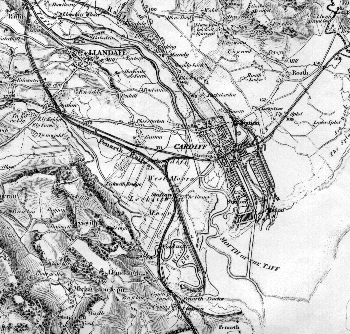South west of the city in the once great flood plain between
the estuaries of the Taff and the Ely lies Hadfield Road. This smooth
and underused stretch of metalled highway connects the old road to Penarth
with the newer A4232 which cuts up out of Cardiff to join the M4 to
the north. Standing here now, looking over the tarmac crossed flats,
with their mix of fast-build low-rise warehouse and glass-fronted block
walled show units you might be mistaken for imagining that water never
got this far. But it did. As recently as last century these were the
West Moors - a land of river gravel overlaid with waterlogged clay and
rough grass; rifted with reens, sluices and ponds. You farmed here if
you had good boots or a boat.
Hadfield Road is Cardiff's answer to mid-west America. No one walks
it. No skateboards. No dogs on leads. The pavements are clear from
start to finish. In the several hours I prowled its length I didn't
see anyone who didn't arrive precisely at their destination by car.
Draw up, open the door, stroll ten yards. That's what this is. Auto
land. Hadfield is car showrooms run together on the me-too principle
from Plexiglas beginning to crystal laminated end. Inside, the ubiquitous
salesmen are all mid-Cardiffian clones - clever enough to catch the
big spenders, patient enough to work the economy end. These guys could
operate anywhere in the Capital. They're swift, slick and they smile.
They sell to couples with babies, middle-aged fatties in trainers
and track suit bottoms, tieless youths with big shirts. At VW, where
style and image have become everything, they are in suits and you
are sir. At Honda they wear polo shirts and call you mate. They put
you at ease, offer you coffee, press brochures in your hands. Prices
have fallen, things are tough, commission is hard to find. There's
a guy outside Mazda in a Chrysler Voyager People Carrier in which
he has installed sixteen speakers and is blasting out garage at more
than 100 decibels. He has the windows down. No one tells him to stop.
We are in sight here of a whole bunch of past Cardiff landmarks.
Grange Farm, which gave Grangetown its name. Canton Moor. Leckwith
Bridge. Bessemer Road and its Sunday market. Ninian Park, where the
fans of the club that once actually roared up through the First Division
now have the reputation of being the most violent in Britain. Check
their fanzines to experience the sprawling, half-literate violence
that blows over soccer like a dark cloud. But they are not in Hadfield
Road buying racers, GTIs, hot hatches, not today.
In the vast Fiat customer car park, full of white vans and coupes,
it begins to rain. A herring gull in its second winter plumage lands
near a parked Brava and, looking lost for a moment, tilts its head,
stares under the tyres. This bird breeds on cliffs and moorland. It
would have been here well before the Italian car maker. Before there
was an Italy. Before Rome, come to that. It takes off through the
Cardiff drizzle, still doing it after thousands of years. It heads
south towards Daihatsu. Why walk. There's no point.

Cardiff from the Ordnance Survey of 1833
Peter Finch
back to the top